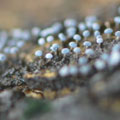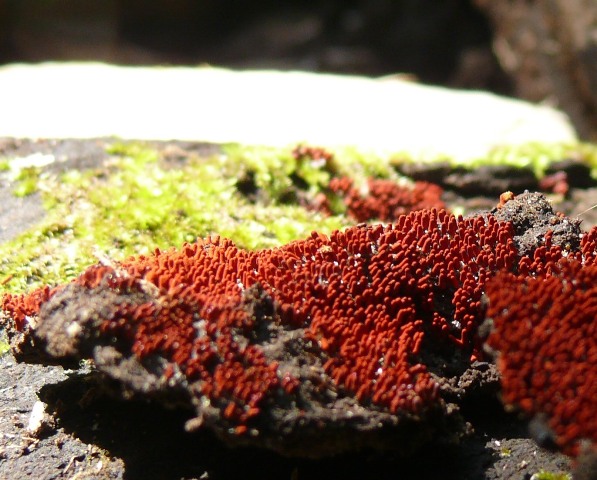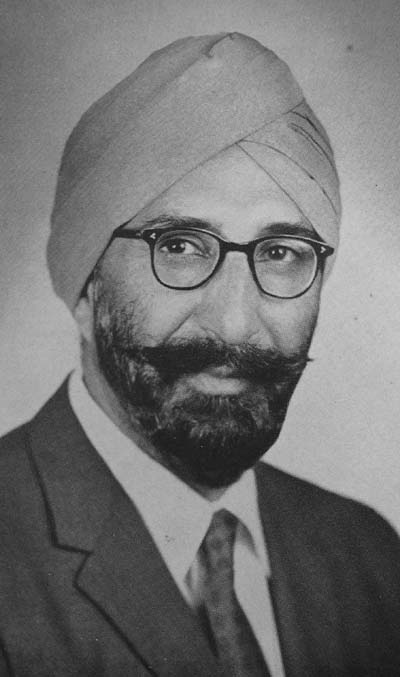~~Welcome to Indian Myxomycetes Reference Database~~
 Myxomycetes:
Myxomycetes:
Myxomycetes are plant-like in their manner of reproduction but resemble animals in the characteristics of their assimilative phase. The organism exhibits two alternating phases in its life cycle, the assimilative phase and the sporulating phase. The former consists of a free-living, acellular, mobile mass of protoplasm i.e., the plasmodium. The plasmodium absorbs nutrients from the surroundings and also engulfs solid particles including bacterial and fungal spores. The sporulating phase (sporocarp) bears spores externally on, or inside, a spore case. The spore case consists of an outer, generally persistent peridium, which envelops a free thread-like netted structure, the capilitium, which aids in spore dispersal. Myxomycetes are a cosmopilitian group of organisms that can be found in a variety of habitats including well-manicured lawns and flower beds, and damp places, especially on old wood or other plant material undergoing decomposition. Slime molds are also common on dung and a few species may be restricted to this substratum. Another more recently recognized, specialized niche is dead branches attached to living trees. The important taxonomic treatises available on slime moulds include Lodhi (1934), Martin & Alexopoulos (1969), Alexopoulos (1973, 1978), Farr (1976), Thind (1977) and Lakhanpal & Mukherji (1981). Several workers also reported Myxomycetes from different parts of India, which were published under the banner of Fungi of India. [Martin GW (1932); Uppal BN, Patel MK & Kamat MN (1935); Mundkur BB (1938); Patel MK, Kamat MN & Bhide VP (1948); Ramakrishnan K, Subramanian CV (1952); Subramaniam CV, Ramakrishnan K (1956); Roy TC (1959); Vasudeva RS (1962); Tandon RN, Chandra S (1963 – 64); Mathur RS (1964); Subramaniam CV, Tyagi PD (1964), Tilak ST, Rao R (1968); Rangaswamy G, Sheshadri VS & Lucy Channama KA (1970); Kamat MN, Patwardhan PG, Rao VG & Sathe AV (1971); Kowalski DT (1973); Mukherji KG, Juneja RC (1974 – 75); Sarbhoy AK, Lal G & Varshney JL (1975); Sekhon SS (1976 – 1979); Bilgrami KS, Jamaluddin S & Rizwi MA (1979); Mishra RL, Ranade VD (1979); Sood R, Lakhanpal TN (1980);Sarabhoy AK, Agarwal DK & Varshney JL (1980 – 1986); Bhide VP, Sathe AV, Pande Alaka, Patwardhan PG & Rao VG (1987); Hosagoudar VB, Abraham TK & Pusphangadan P (1996); Jagtap AP, Singh NP (2002); Jamaluddin S, Goswami MG & Ojha BM (2004); Tembhurne RR, Nanir SP (2011)].  Many fungi were collected in India by Dr. Wight and these were examined by Klotzsch (1830–1833) and Berkeley (1839). Wight was perhaps the first person to collect a slime mould, Physarum cinereum (Batsch.) Pers., from Madras (Chennai), India on grass leaves in 1830 (Lakhanpal & Mukerji, 1981). Three species namely, Physarum conglomeratum (Fr.) Rost. Dictydiaethalium plumbeum (Schum.) Rost. and Lycogala epidendrum (L.) Fr. were collected and reported by Sir J.D. Hooker in 1849–1850 from Sikkim and Darjelling. J.C. Hobson (1862) recorded Hemitrichia serpula (Scop.) Rost. from Bombay (Mumbai). E. S. Berkley recorded 11 species of Myxomycetes between 1864 and 1882 (Lakhanpal & Mukerji, 1981). Pioneer work on slime moulds in India was done by Mrs. A. Drake, who collected them from different parts of India (1911–1927). She made 124 collections belonging to 74 species, which were then identified by Miss G. Lister. Her collection as well as of others are preserved at the Royal Botanic Garden, Kew. Lister (1924) published the first paper on Indian Myxomycetes entitled “Mycetozoa from North India”. This publication was based on 36 collection made by Mrs. Drake from 1912–1919. Bruhl & Gupta (1927) published the second paper on Indian Myxomycetes describing 16 species from West Bengal. Butler & Bisby (1931) compiled a list of Indian Fungi and remarked, “The Myxomycetes have not been studied in India but many of these widely distributed organisms occur there”. They did not include any representative of this group in their compilation. However, Lister A (1894) had already mentioned (under habit only) the occurrence of 18 species in different parts of India. Lodhi (1934) published a monograph of Indian slime moulds describing and illustrating 43 species collected by Mrs. A. Drake.
The period between 1952–1976 can be considered the Golden Period for the studies of Mxyomycetes in India. Around 1952 interest was revived in this field. Dr. K.S. Thind in North India, and Dr. V. Agnihothurudu in South India, started work on Indian Myxomycetes almost simultaneously. Thind et al. (1955–1973) in a series of 24 research papers have described about 175 species from the North Western and Eastern Himalayas and the Punjab Plains. Their contributions include 19 new species and two new varities. Agnihothrudu and his collaborators (Agnihothrudu 1954–1956, 1965–1966; Agnihothrudu & Chinnappa 1968–1969, Indira 1968, 1975) have described 78 species from South India, including one new species. Agnihothrudu (1958–1965) in a series of four papers described 56 species including two new species from North-East India. Ghosh & Dutta (1962) from Orissa, Pathak & Ghosh (1962) from Uttar Pradesh, Kar (1964) from Calcutta, Singh, & Pushpavathy (1965 – 1979), Singh, Pushpavathy & Sethi (1979) from Delhi, Patwardhan & Joshi (1975), Patil & Ranade (1975), Ranade & Mishra (1977, 1979), Chavan & Kulkarni (1974), Thite (1975) from Maharashtra, Dhillon (1978), and Dhillon et al. (1978, 1979) recorded more species of Myxomycetes from their respective places.
In 1977, Prof. Thind published “Myxomycetes of India” describing and illustrating 182 species recorded up to 1973. Lakahanpal T.N. began work on Myxomycetes of Kulu and Simla in 1965, later extending the work to other parts of Himachal Pradesh. From 1965 to 1978 he collected about one thousand specimens, including about 75 from Delhi (1969–1975). In his doctoral thesis, Lakahanpal T.N. described and illustrated 156 species. In this work he recorded 7 genera and 43 species for the first time from India and described 22 species new to science. He also reported 50 species (and one variety) from Delhi, and 83 species from Himachal Pradesh for the first time. He also amended the diagnosis of Metatrichia vesparium and Physarum laevisporum and resolved the controversy regarding the delimitation of the species of Lycogala on the basis of the ontogeny of their corticals scales. Lakhanpal & Mukherji in a series of 19 papers entitled “Taxonomic studies on Indian Myxomycetes – I–XVII” and “Experimental studies on Indian Myxomycetes – I and II” described and illustrated more than 62 species from Himachal Pradesh and Delhi and have recorded their observations on the life cycle and sporangial development of some important species such as Licea scyphoides Keller & Brookes, Macbridela cornea (G. Lister & Cram)Alexop. and Clastoderma debaryanum Blytt. They also conducted cultural studies on some species of Didymium i.e., Didymium muscorum Lakhanpal & Mukherji, D. karstenii Nann.-Bremk., D. intermedium Schroet. and D. squamulosum (Alb. & Schw.) Fr. Earlier, Thind & Lakhanpal (1968a–d) described 16 species and Lakhanpal (1971–1973) 56 species from Himachal Pradesh, including some already described by him with Prof. Thind (loc. cit.). Kowalski & Lakhanpal (1973) and Lakhanpal (1972) described one genus and ten species from Delhi. Lakhanpal (1972) recorded five species from Nainital in Uttar Pradesh.
Many species have been collected from natural habitats since 1976 and some more interesting forms have been obtained, in moist chambers, from the bark of living trees. The work after 1976 has seen contributions from T.N. Lakhanpal, K.G. Mukherji, S.S. Dhillon (1976–1980), S.D. Patil (1977–1979), V.D. Ranade (1977–1979), R.L. Mishra (1977–1979), M.L. Farr (1960–1979), H. Singh (1981), S.P. Nanir (1979 –1985), S.P. Nanir et al. (1987), R.R. Tembhurne & S.P. Nanir (2011), B.G. Rokade & S.P. Nanir (1993), N.E. Nannenga-Bremekamp, R. Pasricha, R. Sharma, R.K. Chopra (1990), S. Kaur (1996), Wrigley and Lado (2005).
Distribution of Myxomycetes in India:
Temperature, humidity, rainfall, and topography are the main factors that determine the distribution of Myxomycetes. It is suggested that Myxomycetes attack wood after it has been partially degraded by Basidiomycetes, but their role in the decay of conifer wood may be understated. The present study provides a checklist containing 373 species of Mxyomycetes, 17 varieties and 4 forms within 50 genera, 11 families and 6 orders. (Table 1). Liceales is the dominant order with 3 families. Stemonitaceae is the dominant family with 12 genera and Physarum is the dominant genus with up to 76 species in India. Worldwide, these 50 genera recorded in India are represented by 2344 species, 523 varieties, 4 subspecies and 58 forms (Table 2). Various classification systems of Kingdom Fungi have been proposed by mycologists, among which is the recent classification system given by Alexopoulos et al. (1996). However, the present study has taken into consideration the Ainsworth system of classification of Fungi. For classification of Mxyomycetes (also called Acellular slime moulds or True slime moulds), a system proposed by Martin et al. (1983) is used.
Many fungi were collected in India by Dr. Wight and these were examined by Klotzsch (1830–1833) and Berkeley (1839). Wight was perhaps the first person to collect a slime mould, Physarum cinereum (Batsch.) Pers., from Madras (Chennai), India on grass leaves in 1830 (Lakhanpal & Mukerji, 1981). Three species namely, Physarum conglomeratum (Fr.) Rost. Dictydiaethalium plumbeum (Schum.) Rost. and Lycogala epidendrum (L.) Fr. were collected and reported by Sir J.D. Hooker in 1849–1850 from Sikkim and Darjelling. J.C. Hobson (1862) recorded Hemitrichia serpula (Scop.) Rost. from Bombay (Mumbai). E. S. Berkley recorded 11 species of Myxomycetes between 1864 and 1882 (Lakhanpal & Mukerji, 1981). Pioneer work on slime moulds in India was done by Mrs. A. Drake, who collected them from different parts of India (1911–1927). She made 124 collections belonging to 74 species, which were then identified by Miss G. Lister. Her collection as well as of others are preserved at the Royal Botanic Garden, Kew. Lister (1924) published the first paper on Indian Myxomycetes entitled “Mycetozoa from North India”. This publication was based on 36 collection made by Mrs. Drake from 1912–1919. Bruhl & Gupta (1927) published the second paper on Indian Myxomycetes describing 16 species from West Bengal. Butler & Bisby (1931) compiled a list of Indian Fungi and remarked, “The Myxomycetes have not been studied in India but many of these widely distributed organisms occur there”. They did not include any representative of this group in their compilation. However, Lister A (1894) had already mentioned (under habit only) the occurrence of 18 species in different parts of India. Lodhi (1934) published a monograph of Indian slime moulds describing and illustrating 43 species collected by Mrs. A. Drake.
The period between 1952–1976 can be considered the Golden Period for the studies of Mxyomycetes in India. Around 1952 interest was revived in this field. Dr. K.S. Thind in North India, and Dr. V. Agnihothurudu in South India, started work on Indian Myxomycetes almost simultaneously. Thind et al. (1955–1973) in a series of 24 research papers have described about 175 species from the North Western and Eastern Himalayas and the Punjab Plains. Their contributions include 19 new species and two new varities. Agnihothrudu and his collaborators (Agnihothrudu 1954–1956, 1965–1966; Agnihothrudu & Chinnappa 1968–1969, Indira 1968, 1975) have described 78 species from South India, including one new species. Agnihothrudu (1958–1965) in a series of four papers described 56 species including two new species from North-East India. Ghosh & Dutta (1962) from Orissa, Pathak & Ghosh (1962) from Uttar Pradesh, Kar (1964) from Calcutta, Singh, & Pushpavathy (1965 – 1979), Singh, Pushpavathy & Sethi (1979) from Delhi, Patwardhan & Joshi (1975), Patil & Ranade (1975), Ranade & Mishra (1977, 1979), Chavan & Kulkarni (1974), Thite (1975) from Maharashtra, Dhillon (1978), and Dhillon et al. (1978, 1979) recorded more species of Myxomycetes from their respective places.
In 1977, Prof. Thind published “Myxomycetes of India” describing and illustrating 182 species recorded up to 1973. Lakahanpal T.N. began work on Myxomycetes of Kulu and Simla in 1965, later extending the work to other parts of Himachal Pradesh. From 1965 to 1978 he collected about one thousand specimens, including about 75 from Delhi (1969–1975). In his doctoral thesis, Lakahanpal T.N. described and illustrated 156 species. In this work he recorded 7 genera and 43 species for the first time from India and described 22 species new to science. He also reported 50 species (and one variety) from Delhi, and 83 species from Himachal Pradesh for the first time. He also amended the diagnosis of Metatrichia vesparium and Physarum laevisporum and resolved the controversy regarding the delimitation of the species of Lycogala on the basis of the ontogeny of their corticals scales. Lakhanpal & Mukherji in a series of 19 papers entitled “Taxonomic studies on Indian Myxomycetes – I–XVII” and “Experimental studies on Indian Myxomycetes – I and II” described and illustrated more than 62 species from Himachal Pradesh and Delhi and have recorded their observations on the life cycle and sporangial development of some important species such as Licea scyphoides Keller & Brookes, Macbridela cornea (G. Lister & Cram)Alexop. and Clastoderma debaryanum Blytt. They also conducted cultural studies on some species of Didymium i.e., Didymium muscorum Lakhanpal & Mukherji, D. karstenii Nann.-Bremk., D. intermedium Schroet. and D. squamulosum (Alb. & Schw.) Fr. Earlier, Thind & Lakhanpal (1968a–d) described 16 species and Lakhanpal (1971–1973) 56 species from Himachal Pradesh, including some already described by him with Prof. Thind (loc. cit.). Kowalski & Lakhanpal (1973) and Lakhanpal (1972) described one genus and ten species from Delhi. Lakhanpal (1972) recorded five species from Nainital in Uttar Pradesh.
Many species have been collected from natural habitats since 1976 and some more interesting forms have been obtained, in moist chambers, from the bark of living trees. The work after 1976 has seen contributions from T.N. Lakhanpal, K.G. Mukherji, S.S. Dhillon (1976–1980), S.D. Patil (1977–1979), V.D. Ranade (1977–1979), R.L. Mishra (1977–1979), M.L. Farr (1960–1979), H. Singh (1981), S.P. Nanir (1979 –1985), S.P. Nanir et al. (1987), R.R. Tembhurne & S.P. Nanir (2011), B.G. Rokade & S.P. Nanir (1993), N.E. Nannenga-Bremekamp, R. Pasricha, R. Sharma, R.K. Chopra (1990), S. Kaur (1996), Wrigley and Lado (2005).
Distribution of Myxomycetes in India:
Temperature, humidity, rainfall, and topography are the main factors that determine the distribution of Myxomycetes. It is suggested that Myxomycetes attack wood after it has been partially degraded by Basidiomycetes, but their role in the decay of conifer wood may be understated. The present study provides a checklist containing 373 species of Mxyomycetes, 17 varieties and 4 forms within 50 genera, 11 families and 6 orders. (Table 1). Liceales is the dominant order with 3 families. Stemonitaceae is the dominant family with 12 genera and Physarum is the dominant genus with up to 76 species in India. Worldwide, these 50 genera recorded in India are represented by 2344 species, 523 varieties, 4 subspecies and 58 forms (Table 2). Various classification systems of Kingdom Fungi have been proposed by mycologists, among which is the recent classification system given by Alexopoulos et al. (1996). However, the present study has taken into consideration the Ainsworth system of classification of Fungi. For classification of Mxyomycetes (also called Acellular slime moulds or True slime moulds), a system proposed by Martin et al. (1983) is used.
About Database
The Indian Myxomycetes Database (IMD) is a simple reference database. Beinig a database of references, the structure of this relational database is very simple and easy to use. About identification numbers in the database : Each record in the database has a unique identification number. For example, 'UID123' stands for 'Unique Identification number 123'. In addition to this identification number there is another identification number which uniquely identifies individual species. This number is called 'IMD' number. This number is useful since there can be more than one references to a single individual species. For example, there are two records for Abortiporus biennis. Thus this record has two UIDs, viz. UID99 and UID729. But the species has single unique IMD number IMD. Accessing the database is possible in two ways : 1. Search : Users can build simple as well as complex queries. The search results are alphabettically arranged according to generic and specific names. The IMD numbers are also given in the search results. 2. Browse : Database can be browsed by three hierarchical catagories viz. Family, Genus and Species. In addition to this, all records can also be browsed at a time. The number of sub entries are shown at each level of browsing. Above two options allow the users to query the database in varied ways. All information of a particular record can be viewed in a card viewer which opens in the same page by clicking on a name in the search/browse result. External Links : The Indian Myxomycetes Database (IMD) has been linked to MycoBank. Technical details about the database and web-implementation : Database Management System : MySQL 5.0 Server : Apache 2.2 Server side script : PHP Cleint side script : javascript Browser support : All the web pages of this site are successfully tested on Mozilla Firefox 3.5.6. (Get Mozilla Firefox)
Myxomycetes Photogallery
Work in progress!
Education
Work in progress!
DIV 4
|
e-mail: ranadive.kiran@gmail.com [Fungal data collection , compilation, editing and website layout designing] Prof. Neeta Jagtap email: admin@fungifromindia.com [Data feeding & editing] |



